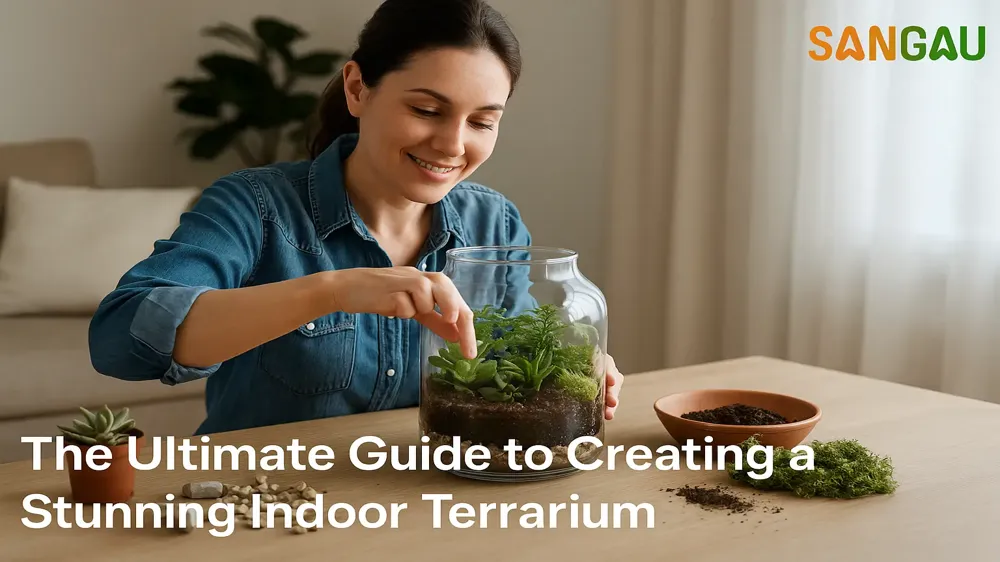The Ultimate Guide to Creating a Stunning Indoor Terrarium
Published : 24 Jun 2025

The Ultimate Guide to Creating a Stunning Indoor Terrarium
Indoor terrariums offer a mesmerising way to bring nature indoors, providing a self-sustaining, low-maintenance miniature garden that thrives in any indoor space. Whether placed on a desk, shelf, or coffee table, these tiny ecosystems combine art and horticulture, offering a relaxing and creative outlet for beginners and gardening enthusiasts alike. With endless possibilities for design and personalisation, terrariums allow you to create a lush green sanctuary, even in the smallest of spaces. Let's explore the essential steps for crafting your perfect indoor terrarium.
Understanding Terrariums: The Basics
A terrarium is essentially a small, enclosed garden housed in a transparent container, designed to mimic natural ecosystems. There are two main types: closed terrariums, which retain moisture and create a humid environment ideal for ferns and mosses, and open terrariums, which allow air circulation, making them perfect for succulents and cacti. Understanding this distinction is crucial for selecting the right plants and setting up a healthy, thriving miniature garden.
Selecting the Perfect Container
Your choice of container forms the foundation for your terrarium’s aesthetics and functionality. Clear glass jars, fishbowls, vases, or repurposed household items like old lanterns or bottles all make excellent choices. Closed containers help retain humidity, while open ones allow air circulation, preventing excess moisture buildup. A transparent container ensures ample light reaches the plants, fostering a vibrant and thriving ecosystem.
Creating the Ideal Base Layer
A well-structured base layer is key to maintaining plant health. Begin with small pebbles or gravel to facilitate drainage, preventing water from accumulating at the bottom. Follow this with a layer of activated charcoal, which acts as a natural filter, eliminating odours and preventing mould growth. This foundational setup ensures your terrarium remains fresh and well-balanced.
Choosing and Preparing the Right Soil
The type of soil you use significantly impacts plant growth. For moisture-loving plants like ferns and mosses, nutrient-rich potting soil is ideal. Succulents and cacti thrive in well-draining soil mixed with sand or perlite. Spread the soil evenly over the charcoal layer, ensuring it’s deep enough to support the roots while maintaining optimal moisture balance for plant health.
Picking the Best Plants for Your Terrarium
Selecting the right plants is essential for a successful terrarium. Closed terrariums flourish with humidity-loving plants such as mosses, ferns, and air plants. Open terrariums are best suited for drought-resistant species like succulents, cacti, and aloe vera. Consider the size and growth habits of each plant, ensuring they complement each other and fit comfortably within your chosen container. Combining plants with different textures and colours can enhance the overall aesthetic appeal.
Arranging and Planting Your Mini Garden
Now for the exciting part—arranging and planting your terrarium. Start by making small holes in the soil for each plant. Carefully remove the plants from their nursery pots, shaking off excess soil before positioning them in your chosen layout. Allow space between the plants for growth and aesthetic balance. Once placed, gently pat the soil around the roots to secure them. This step allows your creativity to shine as you craft a unique, miniature landscape.
Enhancing Your Terrarium with Decorative Touches
Adding decorative elements transforms your terrarium into a personalised work of art. Incorporate small stones, pebbles, seashells, driftwood, or figurines to create a theme that reflects your style. Whether you envision a tranquil Zen garden with sand and miniature rakes or a whimsical fairyland with tiny figurines, these embellishments add depth and character, making your terrarium a striking home feature.
Managing Moisture for a Healthy Ecosystem
Proper moisture balance is key to terrarium maintenance. For closed terrariums, mist the plants lightly before sealing the container, allowing the natural water cycle to maintain humidity. Open terrariums require occasional watering—ensure the soil is moist but not soggy to prevent root rot. Overwatering can lead to mould, while underwatering can cause plants to dry out. Regularly observing soil and plant health will help maintain optimal conditions.
Providing the Right Amount of Light
Light plays a crucial role in the longevity of your terrarium. Indirect sunlight is ideal, as direct exposure can overheat the container and scorch the plants. Place your terrarium near a window with filtered light or use grow lights if natural light is insufficient. Different plants have varying light needs, so researching their specific requirements ensures they remain healthy and vibrant.
Keeping Your Terrarium Thriving with Maintenance
Regular care keeps your terrarium looking fresh and thriving. Monitor plant growth, remove yellowing leaves, and trim overgrown sections to prevent overcrowding. If condensation forms on the walls of a closed terrarium, briefly open the lid for ventilation. Checking for signs of pests, mould, or excessive moisture ensures your indoor garden stays in peak condition for years to come.
Bonus Tip: Experiment and Personalise
One of the joys of terrariums is the ability to experiment with different designs and containers. Repurpose unique items like old light bulbs, teacups, or glass bottles for a creative twist. Mixing plant varieties and textures can also add a visually captivating element to your design. Let your imagination guide you as you create a one-of-a-kind indoor oasis.
In Conclusion
These captivating miniature ecosystems are not only an aesthetic addition to your home but also a rewarding, low-maintenance gardening experience. Whether you’re a beginner or a seasoned plant enthusiast, creating a terrarium offers endless possibilities for creativity and relaxation.
Hashtags:
#IndoorGardening #TerrariumLove #MiniatureGarden #HomeDecor #SANGAU


